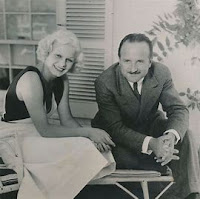at a young age, was short-lived, ending as Harlow began her rise in Hollywood.
Paul Bern (1932): Bern, a film executive at MGM, was found dead in their home just two months after their marriage. His death was ruled a suicide, but
the circumstances remain shrouded in mystery and gossip.
the circumstances remain shrouded in mystery and gossip.
Harold Rosson (1933–1934): Her third marriage to the MGM cinematographer was
reportedly a publicity stunt and ended amicably. Harlow also had a long-standing relationship with actor William Powell, but they never married, despite her desire to do so. Career Struggles and Family Pressure Harlow's rise to fame in the 1930s placed her in the spotlight, but she often found herself at odds with the pressures of stardom and her demanding schedule at MGM. Her mother, who was highly controlling, added to her stress, as did the public scrutiny of her personal life. Health Issues and Untimely Death Jean Harlow's life was tragically cut short when she died on June 7, 1937, at just 26 years old, from complications of kidney failure (then known as uremic poisoning). She had been ill for several days while filming Saratoga but refused to stop working. Her sudden death shocked the film industry and her fans. Legacy Despite her brief life, Jean Harlow left an indelible mark on Hollywood. Her beauty, charisma, and comedic timing made her one of the first true movie stars, and she became a symbol of 1930s glamour. Her personal life, filled with both passion and heartache, only added to her mystique.
reportedly a publicity stunt and ended amicably. Harlow also had a long-standing relationship with actor William Powell, but they never married, despite her desire to do so. Career Struggles and Family Pressure Harlow's rise to fame in the 1930s placed her in the spotlight, but she often found herself at odds with the pressures of stardom and her demanding schedule at MGM. Her mother, who was highly controlling, added to her stress, as did the public scrutiny of her personal life. Health Issues and Untimely Death Jean Harlow's life was tragically cut short when she died on June 7, 1937, at just 26 years old, from complications of kidney failure (then known as uremic poisoning). She had been ill for several days while filming Saratoga but refused to stop working. Her sudden death shocked the film industry and her fans. Legacy Despite her brief life, Jean Harlow left an indelible mark on Hollywood. Her beauty, charisma, and comedic timing made her one of the first true movie stars, and she became a symbol of 1930s glamour. Her personal life, filled with both passion and heartache, only added to her mystique.
BJ 🙈🙉😘






